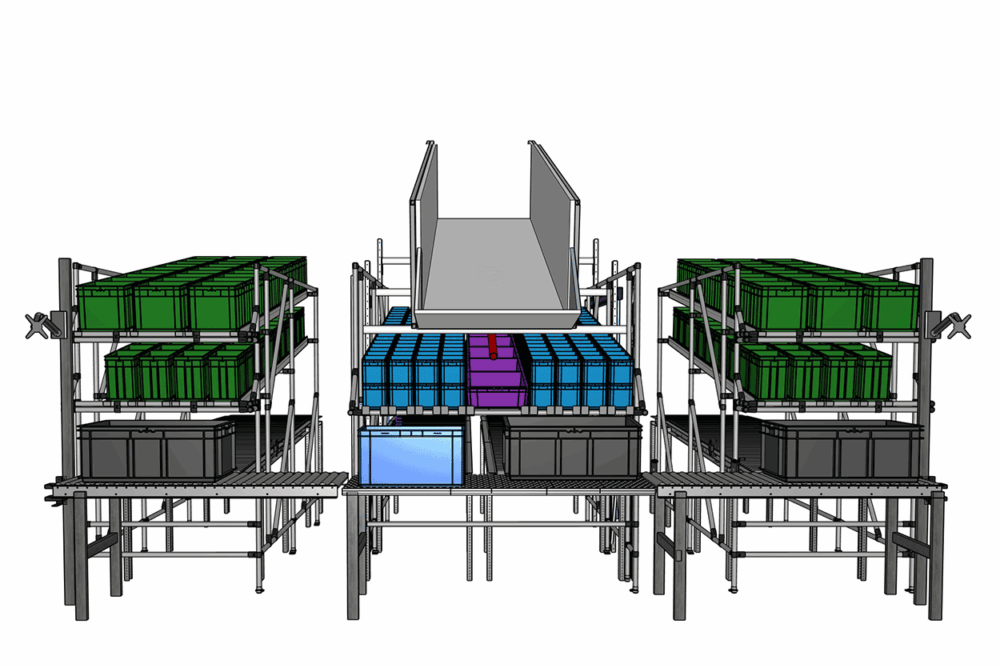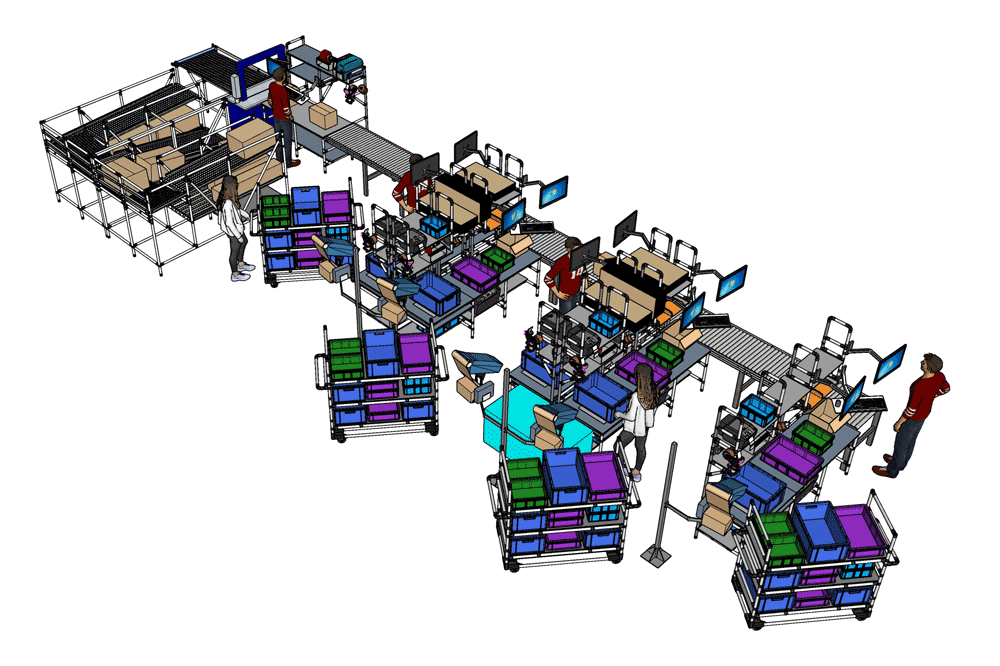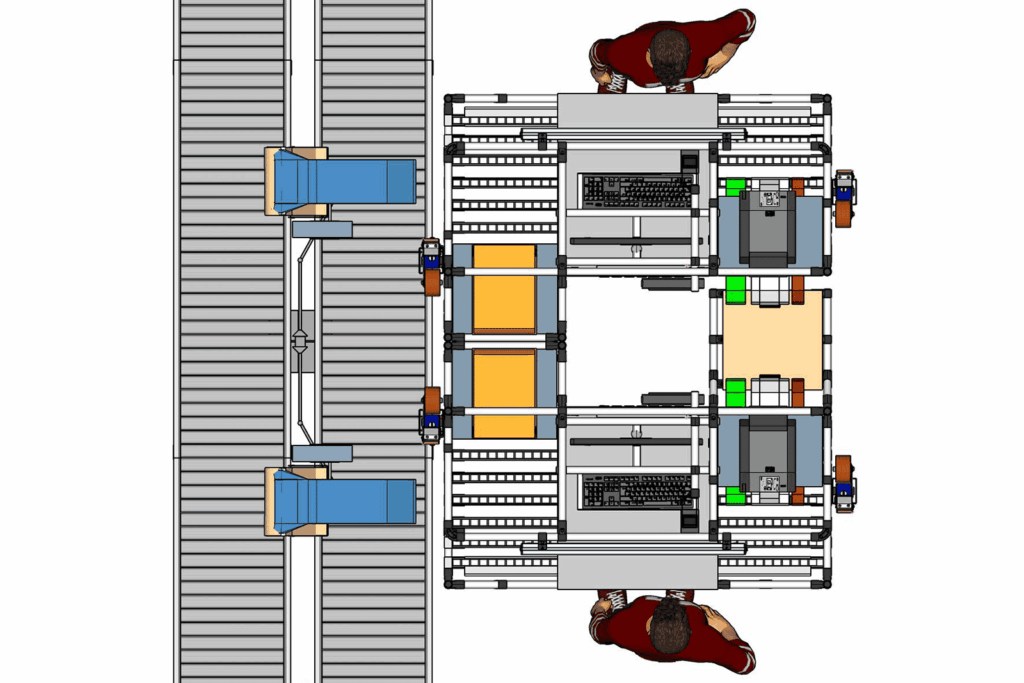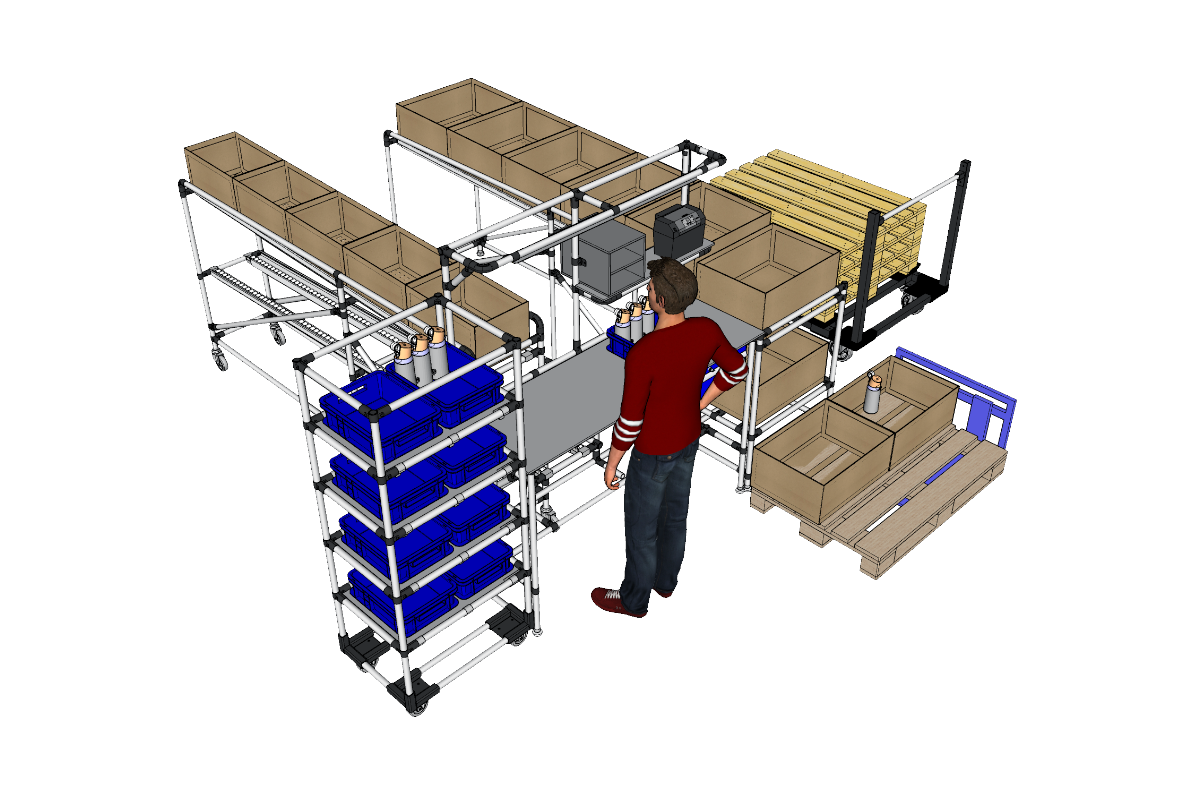Ergonomics is not only decided at the work surface, but also in the flow: where material arrives in a defined quality, quantity and height, is handed over and triggers the next movement. A workstation can appear ergonomic and yet cost energy in the process - if material, cycle and movement do not fit together. Only the interaction between people, materials and information makes ergonomic processes stable and economical.
Understanding movement - and shaping it
In industrial practice, it is rarely a question of avoiding movement. It is more important to uniform and comprehensible design. Not every movement is a waste - the decisive factor is whether it supports or interrupts the process.
Experience has shown that when material transfers, gripping points and directions of movement harmonise, a natural rhythm is created. This rhythm relieves the body, stabilises the execution and reduces unconscious compensatory movements.
Example: In a line assembly, unsynchronised replenishment led to changing movement patterns. Only with a fixed cycle and clearly defined transfer points could the movements be standardised - the process became smoother and more consistent.
Ergonomics is effective where movement sequences become reproducible - in other words, where Material flow and workplace design are conceived together.
Transfer heights and gripping spaces - ergonomic planning
Ergonomic handovers are where strength, vision and control come together. The dimensions are known - the decisive factor is matching them to the activity and frequency.
- Gripping zone: frequently used parts 50-60 cm in front of the body, with slightly inclined support to guide the hand.
- Transfer heights: usually between 80-110 cm; heavy components tend to be lower, precise work somewhat higher.
- Roller conveyors or FIFO systems: with 3-7 ° inclination and end stop at gripping height prevent unnecessary pulling movements.
Example: In an order picking system, small load carriers were provided on flat levels. After installing a flat inclined FIFO lane with an end stop at a height of 95 cm, the picking time was reduced and mispicks occurred less frequently - hand, eye and container edge were in a fluid movement path.
There was also a clear effect with lateral roller conveyors: half a turn less per handle saves energy and keeps movement sequences constant over the shift.
Docking points in the material flow
An ergonomic workstation only remains efficient if material arrives in a reproducible position. Standardised docking points are therefore a key factor in ergonomic material flow.
- Tugger train transfers: Defined height, clear stop, reproducible approach position.
- AMR docking: mechanical guidance, fixed tolerances, clear sensor technology.
- Repatriations: Short, clear zones prevent improvised temporary storage.
Example: In a pre-assembly phase, a variable parking point for the tugger train led to changing grip patterns. With fixed docking dimensions - identical in height and distance to the working edge - the movement sequence became noticeably more stable.
We know from our practical experience that even minor deviations in docking heights lead to unconscious additional movements. Standardised dimensions create safety and reduce deviations - across layers and users.
Ergonomic movement in the process
Ergonomics does not end at the edge of the table. Cycling, replenishment and variant changes also determine how smoothly employees can work. Where supply, heights and spacing remain stable, calmness is created in the process.
- Replenishment cycles: plannable, visible, clearly acknowledged.
- Buffer sizes: As small as possible, as large as necessary.
- Variance: by adapters or inserts so that gripping profiles remain constant.
Example: In a final assembly line, the standardisation of transfer heights during variant changes led to significantly fewer interruptions. The process also stabilised in an e-commerce packing line when the tugger train delivered at fixed intervals - the change from refilling „on demand“ to a rhythmic material flow made all the difference.
Cognitive ergonomics - see what comes next
Movement follows information. Information is ergonomic when it can be perceived without searching - in the field of vision and reach, where it is needed.
- Displays at eye level, glare-free and contextualised.
- Scanner and acknowledgement in the reach zone with clear feedback.
- Supply status visible: Simple signals are often sufficient.
Example: A packing station displayed the replenishment status (FIFO empty / tugger train en route) in the field of vision. Interruptions decreased and the packing speed remained more consistent.
In an assembly cell, a visual display showed the AMR status - keeping the focus on the process, not the organisation.
Movement remains dynamic - even across shifts
Uniform strain is not a state, but an interplay. Workstations should allow small variations in movement - this keeps the muscles active without disrupting the process.
- Height adjustment with stop dimensions facilitates the shift change.
- Interchangeable handles (left/right) promote symmetry at high cycle rates.
- Small variations prevent fatigue and increase concentration.
Example: Two predefined working heights in the packaging area reduced fatigue and cycle dispersion. Elsewhere, a variable footrest provided more freedom of movement - the result: more stable performance over long shifts.
Digitalisation - feedback instead of control
Digital systems are not an end in themselves, but tools to make process behaviour visible. Simple feedback - such as signals for reorder levels or time stamps for each work step - help to recognise changes without disrupting the process.
We know from our project experience: Data does not have to be extensive to be meaningful - the decisive factor is its readability in everyday life.
- Timestamp for trend monitoring.
- Handle frequency and interruption rate as simple indicators after layout changes.
- Automatic replenishment trigger relieve the organisation.
Example: After standardising the docking dimensions, the average cycle time remained the same and the variation decreased significantly. Ergonomics therefore pays off above all in terms of consistency - and therefore predictability and process quality.
Practical impulses - small adjustments, big impact
- Defined gripping edge: Inclined end position, grip edge can be felt, end stop decoupled.
- Standardised transfer heights: for tugger trains, AMR and manual replenishment.
- Discipline buffer: 1-2 containers in the inspection/gripping belt, the rest in the flow.
- Encapsulate variance: Workpiece carriers or inserts ensure repeatability.
- Feedback in the eye band: Signals in the field of vision, not to the side or above.
- Check movement logic: Different grip patterns often indicate process deviations.
Conclusion
Ergonomics in material flow means Guided movementshort distances, defined heights, clear transfers, visible signals. This results in reproducible processes - and therefore less scatter, fewer errors and less compensation.
Our experience shows that an ergonomic effect is most effective when it is part of the material flow - not an afterthought. Modular customisable Workstation systems, ergonomic roller and FIFO modules, standardised docking points and connectable digital feedback contribute to making movement a real performance factor.




